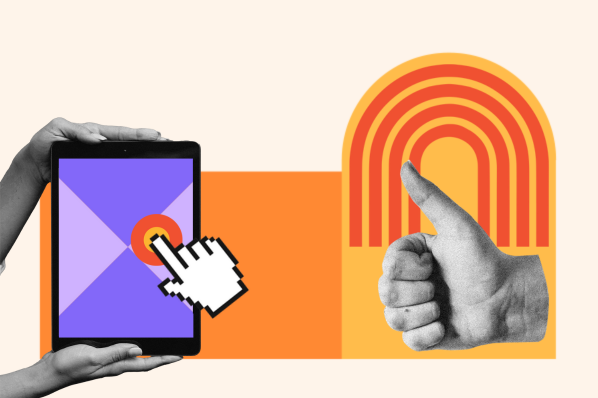But don't panic: Creating a UX problem statement isn't too tricky. I'm here to walk you through everything you need to know about what it is, how to develop your own, and why you can't proceed without a UX problem statement. Lastly, I'll even share some examples that can help you start writing your own.
What is a UX problem statement?
A UX problem statement is a brief description of the problem your team is solving for. It clearly outlines an issue or obstacle users face within your product or service. Typically, it will include information about the users who are experiencing the problem, additional context regarding when the problem occurs, and the consequential impact on user experience. (Psst: These 10 tips can help you improve your site UX quickly and efficiently.)
The UX problem statement is widely considered a must-have because it forces designers to reflect on what went wrong in the original design and keeps the team solution-oriented. With a identified problem to hone in on, you can decide better how to tackle it.
When to Write a Problem Statement
The key to a successful UX problem statement is that you don't wait too long to write it. Because you will want to reference your problem statement throughout the design process, it's important that you have it easily accessible and, therefore, allow it to guide the decisions you will make. For instance, if your team waits to write a problem statement until it's done with building a high-fidelity prototype in Figma, it's already too late to make the most of it.
Because of this, designers typically write a problem statement during the research or discovery phases of the process. This is also an ideal time to do so since you're already collecting insights about your users' needs and pain points. Therefore, by identifying the problem early, you can guarantee that all of your design efforts directly address the issue.
How to use a UX Problem Statement
I'd encourage you to consider your UX problem statement your "north star" as you iterate to solve for the user. By doing so, you can rest assured that you won't reflect on what you've created at the end of the process only to realize that it doesn't solve your users' problem at all.
Influence your decisions throughout the design process.
Probably the most important thing your UX problem statement will do is help inform your team's decisions throughout the design process. Because everyone on the team will clearly understand exactly what needs to be accomplished, the statement will help ensure alignment and reinforce that all decisions made will be working towards fixing this issue.
Inspire your team as you brainstorm.
Have you ever heard the saying, "A problem well-defined is a problem half-solved?" This quote, typically attributed to John Dewey, is true in my experience. Your team may also find that with the problem well-defined, brainstorming is more seamless and efficient.
Drive research.
Does your team have more questions about the problem at hand? If so, you may consider digging deeper by asking follow-up questions or running a focus group. When you have an apparent problem, you can quickly figure out what pieces of the puzzle you are missing — and then do the research necessary to get them.
Ensure a user-centered design.
We've all used products that were created without a user-centered approach to design. Yes, it does make that big of a difference! Using your UX problem statement, you can help bolster the chances of creating a product that feels user-centered to the people who matter most: Your users.
How to Write a UX Problem Statement in 4 Steps
Writing a UX problem statement isn't too hard. The most important thing you can do is ensure you have all your information handy. If you do so, you should be able to write an effective UX problem statement in four simple steps.
1. Ask yourself: Who is the user?
Your first step is defining the users experiencing the issue. Does the problem span different personas, or is just one persona experiencing difficulty? Having an answer to this will help inform the way you tackle the problem. Plus, you'll have more insight into their behavior once you identify the subset of users experiencing the issue.
2. Describe the problem concisely.
This one's important! Your next step is to identify the problem clearly. The briefer, the better — but ensure you're articulating the issue correctly. For example, you may write that your users are experiencing frustration due to the main horizontal menu dropdown that disappears within two seconds, which is too quick for them to decide which dropdown option to select.
3. Identify the impact it is having.
Going with the example from earlier, are users unable to click the dropdown menu in enough time? Is it resulting in important pages that are going unseen simply because users can't access them? Examine the impact that this issue has on the user experience. This is crucial because it demonstrates why addressing the problem is paramount.
4. Define your goals.
This is your chance to clearly outline what you hope to achieve by reworking this feature. Don't be afraid to get specific. As a rule of thumb, your goals should be measurable and work to enhance the user experience.
This isn't a step but a recommendation. I highly suggest you make your UX problem statement actionable. This helps ensure that you actually solve the problem at hand.
Problem Statement Template
To properly use this problem statement template, you'll need to gather the following:
-
The specific challenge they are facing
-
The context when the challenge occurs
-
The impact on their experience with the product
Once you have these, you can plug them into the problem statement template. Here's one I like to use:
"[INSERT PERSONA HERE] is facing [INSERT CHALLENGE HERE] when [INSERT CONTEXT IN WHICH CHALLENGE OCCURS], which is impacting their ability to [IMPACT OF THE CHALLENGE]."
You might want to experiment with your problem statement a few times to find one that's most effective. Keep in mind this is just a sample — you can tweak the phrasing to make it feel more intuitive to you.
UX Problem Statement Example
Going back to that earlier example I shared with you, I'll walk you through a UX problem statement example.
Say you work for a graphic design agency, and one of your key personas is a content marketer who lands on your site to learn more about your design services. For the sake of this example, we'll call the persona 'Marketing Mary.'
Marking Mary is experiencing frustration because the menu dropdown disappears within two seconds, which is too quick for Marketing Mary to decide which page she wants to select. Furthermore, those pages that are nestled within the dropdown and, therefore, inaccessible to the user, are garnering virtually no traffic.
Here's what your UX problem statement may look like:
"Marketing Mary is facing a menu dropdown challenge as the dropdown disappears within two seconds when she hovers over the site menu. This impacts her ability to navigate to the website's 'Contact' and 'Learn More' pages."
My statement was getting long, so I broke it down into two sentences, which you're welcome to do.
See? It's brief, clear, and demonstrates to the rest of the team exactly what they need to solve.
Create a Meaningful UX Problem Statement
As long as you keep your UX problem concise and clear, you're going to do a great job writing one that helps your team solve whatever problem it is your users are facing.
User Experience
.png?width=112&height=112&name=Image%20Hackathon%20%E2%80%93%20Square%20(10).png)

.png)


![How to become a UX designer, a step-by-step guide [expert tips]](https://53.fs1.hubspotusercontent-na1.net/hubfs/53/become-a-ux-designer-1-20240731-321437.webp)


![How to Add a Parallax Scrolling Effect to Your Website [Examples]](https://53.fs1.hubspotusercontent-na1.net/hubfs/53/scroll-Aug-11-2023-05-24-08-8793-PM.png)

![20 UX Design Examples Hand-Picked by Experts [With Analysis]](https://53.fs1.hubspotusercontent-na1.net/hubfs/53/ux-design-examples-1-20250404-8425368.webp)
